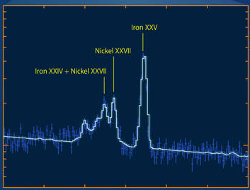 HEAPOW: Making Up Perseus (2017 Dec 11)
HEAPOW: Making Up Perseus (2017 Dec 11)
Supernovae explosions are largely responsible for enriching the Universe with chemical elements more complex than hydrogen and helium. These violent explosions distribute chemical elements into the interstellar environment (and cook up new elements in the process). And the process does not end with the stellar explosion: mergers of neutron stars, left behind by the explosion of massive starss, can produce high atomic number elements like gold. But how does this process work throughout the Universe, and how does the composition of the Universe compare with the composition of our solar system? To help find out, the Hitomi X-ray Observatory made a high-priority observation of the Perseus Cluster, a cluster of galaxies relatively close to the Local Group (to which the Milky Way belongs). The galaxies in the Perseus Cluster orbit through hot, X-ray producing gas, generated by supernova of stars in the member galaxies, and other energetic processes. Hitomi carried a revolutionary new type of instrument, the Soft X-ray Spectrometer (SXS), an X-ray "calorimeter" which measures extremely precise variations of X-ray emission with wavelength by detecting tiny changes in the detector temperature when an X-ray is absorbed by it. The image above is a montage summarizing this new Hitomi result. The inset image on the upper right shows an X-ray image of the hot gas in the Perseus cluster taken by the Chandra X-ray Observatory, with the Hitomi Soft X-ray Spectrometer fields outlined in blue. The upper graph shows the X-ray emission spectrum of the hot gas in Perseus as seen by the SXS. The spikes in the spectrum are X-ray emission produced by ionized atoms within the hot cluster gas. Two wavelength regions of this emission are highlighted in the lower graphs. The spectrum on the left features emission from chromium, manganese, and iron; on the right, iron and nickel. Careful analysis shows that the abundances of these elements are very similar to the abundances of these elements near the Sun, showing the surprising result that both regions experienced a similar chemical enrichment during their very different histories.
GSFC: Hitomi Glimpses Cosmic 'Recipe' for the Nearby Universe
http://asterisk.apod.com/viewtopic.php?t=37755
| << Previous HEAPOW | High Energy Astrophysics Picture of the Week | Next HEAPOW >> |